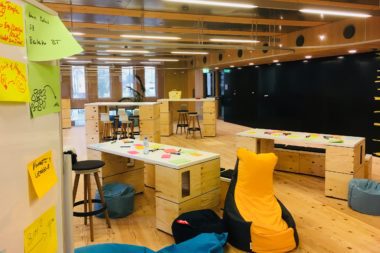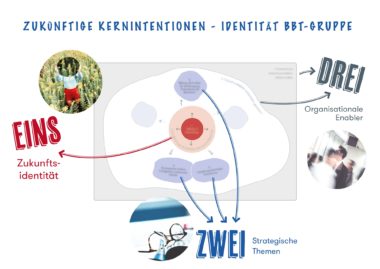In Europe, we face a huge gap of untouched intellectual potential. On one side of the gap, we have highly competitive, research-intensive universities. This is particularly true of biomedical research. On the other side, we have investors ready to exploit these results. However, on one side, we have young, highly talented, and motivated students and researchers who lack entrepreneurial skills; on the other, we have venture capitalists who are spooked by this lack of entrepreneurial skill.
What’s clearly needed is a significantly more effective intermediary system to facilitate the commercialization of university research: an integral link between academic institutions and the business community. Such an initiative would create viable investment opportunities for investors and sponsors, ultimately driving not only growth and innovation in the European market but also refinancing basic research as a foundation for future applications and innovations.
Importantly, this approach focuses on fostering innovation beyond the realm of gimmicky digital tools and apps, which often have a marginal impact on the European economy and risk being outsourced outside the EU. Instead, by effectively bridging the gap between academia and commercial industry, we pave the way for robust businesses based on tangible infrastructure, job creation, and the strengthening of European manufacturing and production sectors. A prime example of the potential of this model is BioNTech in Mainz, Germany, which is making the community more prosperous.
Why is there such a gap in the first place? The opportunity looks attractive – a quick win for all involved. However, starting a spin-off is never easy, even more so for academics. A lack of entrepreneurial culture and risk-taking is an obstacle for projects that require large amounts of capital with the prospect of long-term profitability. And legal constraints such as the hurdles of IP transfer, can be daunting. All this is particularly true for biotech spin-offs or biomedical technology, which depend on lengthy patient trials as well as expensive equipment.

The difference between Europe and the Anglo-American World
This issue is, however, unique to Europe. The culture in the Anglo-American world, especially the U.S., is very different. It wasn’t always smooth there, either. Initially, U.S. universities began patenting and licensing their discoveries in the 1920s. After World War II, the U.S. government increasingly supported university research. However, moving ideas to businesses was slow because the government kept the patents. By the 1970s, special offices were set up in universities to handle patents and licenses. Still, the universities struggled with complicated rules until the Bayh-Dole Act in 1980. This act lets universities own the patents funded by the government, making it easier to turn their research into products. Since then, these university offices have been better at getting new technologies into the market.
The Bayh-Dole Act did more than just change the legal playing field. It facilitated a broader cultural and structural change in the US, encouraging universities and researchers to think more entrepreneurially about the potential of their discoveries. Structural changes (involving establishing technology transfer offices) supported this cultural shift as universities strengthened their technology transfer offices and fostered partnerships with industry. Together, these changes helped to create an ecosystem in which academic research could more easily be translated into commercial products and in which innovation was actively pursued not only for its academic interest but also for its potential market value.
To illustrate the success of this approach, in 2021, Stanford University saw the creation of 25 new companies based on Stanford technology, with options or licenses. As of August 31, 2021, Stanford held equity in 256 companies due to licensing agreements. That year, the liquidation of equity in 22 companies brought in $51.9 million for the university.

The European Gap: The Case of Germany and Austria
That being said, let us return to Europe, specifically Germany and Austria. There is a broad consensus that German universities have more to offer when it comes to kick-starting new businesses. The government’s own startup strategy from earlier this year points out a clear gap: Germany, along with the EU, is great at research but unable to turn that research into spin-offs, companies, and opportunities for investors or private equity funds.
Austria faces similar challenges. The number of university spin-offs in Austria is generally considered too low. The current government program (2020-2024) includes the introduction of performance indicators for academic startups, aiming for a 100% increase in academic spin-offs by 2024. There are significant legal uncertainties in Austria, particularly concerning IP usage. Practitioners call for the establishment of universal standards to guide responsible parties, supported by relevant ministries and the Austrian Court of Auditors.
Both German and Austrian universities also prioritize teaching and research over the creation of academic spin-offs. On the face of it, this testifies to the independence of universities, which is an essential asset of public education and the social agenda of making education widely accessible. However, the de-prioritisation of knowledge transfer is at odds with European research programmes such as Horizon Europe, which increasingly focus on societal impact. Moreover, the protection of academic research from commercial (and political) interests and the freedom of research and education must be upheld – but not at the expense of the third mission of universities. Quite to the contrary, the knowledge created by public universities is knowledge created for the public, even if universities choose their research objectives independently of the public interest. Moreover, academic research often reflects and is inspired by events and needs outside the academy and seeks to explain and make sense of them. Thus, there is an inherent tendency for some academic research (even basic research) to feed back into the world that inspired it.
Especially in Austria, each spin-off case is currently unique. There are no clear rules on how universities should handle equity shares or royalties, leading to inefficiencies in the spin-off process. International studies show that 70% of spin-off projects abroad are negotiated and concluded within six months, while in Austria, the average is four years. Despite some initiatives, such as the cooperation of entrepreneurship centers at Austrian universities, progress in this area has been limited.
This brings us to another point. University leadership often drives such spin-off initiatives by trying to create the necessary structures. But while university leaders are often aware that they need to take action to create new spin-offs and deepen industry-academia collaboration, they need to develop much more effective competencies to foster such collaboration. Leaders must be able to develop a strategic vision and long-term partnerships, be proactive in commercializing research, and understand industry needs. And they must develop and implement supportive policies and strategies, foster an environment of trust and entrepreneurial skill-building, and carefully select individuals for collaborative projects. As such, their involvement is critical to bridging the gap between academic research and industry, ensuring mutual understanding and commitment, and ultimately facilitating successful university-industry collaborations.
Challenges for Spin-Offs and University-Industry Cooperation
A critical step in overcoming the divide between academia, industry, and capital owners is to level the playing field between them. Universities or academia and the industry and finance are vastly different worlds. Both stakeholders from academia and industry or capital owners must manage their expectations and find a common way of working together. They need to strategically integrate their efforts at an intermediary level that addresses the following challenges:
Temporal expectations
Academia is typically invested in the pursuit of knowledge and a long-term perspective, which is not subject to strict deadlines, while industry partners and investors prioritize efficiency, monetization, and rapid turnaround to remain competitive. This fundamental difference in time perspective can lead to misaligned expectations, with academia seen as moving at a deliberate pace and industry as moving at speed. Also, the goals and perceived urgency of projects vary greatly between academia and industry. Universities may pursue knowledge production for its own sake, often with a more relaxed timeframe, while companies seek tangible results that can quickly impact the market and the return on investment. Reconciling these different perspectives is crucial to the success of spin-offs.
Team composition
Building an effective team for spin-offs requires a different approach than in academia. In the university environment, researchers often work independently towards their own academic goals, but in business organizations (including spin-offs), the aim is to foster a unified team working towards a common business goal. The transition from an individualistic academic mindset to a unified, team- and business-centered approach in a spin-off can be challenging, especially if team members are accustomed to the autonomy of academic research.
Resource sharing
Academic institutions typically allocate resources, such as laboratories and equipment, solely for teaching and research purposes. For industry-academia collaborations to thrive, there needs to be a cultural shift towards sharing these valuable resources. This involves not only logistical arrangements but also a fundamental change in how universities view the use and ownership of their assets.
Institutional rigidity versus flexibility
Universities and academia often operate within a framework of established protocols and hierarchies, which can stifle the dynamic interaction required for effective collaboration with the industry. The structured nature of academic institutions contrasts with the more agile and adaptable corporate structures, making it difficult to align processes and decision-making pacing.
Communication gaps
Effective communication is the cornerstone of any successful spin-off. Academics and industry professionals sometimes seem to operate in different linguistic universes, with specialized terminology that can create barriers. Finding a common language and joint understanding that transcends disciplinary jargon is essential for clear and productive interactions and for attracting funding outside traditional academic funding instruments.
Research dissemination
There is a philosophical divide between academia and industry on how to deal with research results and intellectual property. Academics often advocate the free flow of knowledge, believing that this promotes scientific progress, while companies tend to protect research as proprietary and use it for strategic advantage. This difference in approach can lead to disagreements over publication and intellectual property rights.
In conclusion, while the potential for synergy between academia and industry in Europe is enormous, particularly in the field of biotechnology and biomedical research, several structural and cultural barriers prevent this potential from being fully unleashed. The entrepreneurial ecosystem that thrives in the United States, supported by legislation and a culture of innovation, contrasts sharply with the cautious, risk-averse approach that prevails in Europe. Germany and Austria, despite their strong academic foundations and promising research results, are emblematic of the broader European challenge of translating scientific findings into market-ready innovations to unfold their impact on society.
The solution lies in fostering an environment that not only encourages but also systematically supports the transition from academia to industry. This involves not only the financial and economic dimension but also streamlining legal processes around IP transfer, cultivating an entrepreneurial mindset within the scientific community, and incentivizing risk-taking among researchers, founders, and investors. It also requires efforts to build strong bridges between the ivory towers of research and the fast-paced world of business, ensuring that resources, goals, and communication channels are aligned and that the shared mission of innovation is not lost in translation.
Europe stands at a crossroads where the path chosen could lead to a flourishing of innovation and entrepreneurship similar to the successes of the Bayh-Dole era in the U.S. The challenge is to create a framework within which universities’ intellectual and creative capital can be channeled into the economy, driving economic growth, positive societal impact, and progress. The seeds are already in the soil – we only lack the enabling conditions for it to grow.
In our next blog post, we’ll add to the current discussion by exploring a project we embarked on with the Medical University of Graz. We at theLivingCore have been instrumental in driving the University’s strategic profiling process, creating a future-oriented profile that reflects today’s discussions. The result: a clear vision of a culture of collaboration between industry and academia that effectively links basic medical research to patient care and medical innovation. So be sure to come back if you found this to be an interesting read.
Subscribe to Our Newsletter
Keep your innovative edge with more stories like this and additional reading tips, muses, and project updates.
Photo by ANIRUDH on Unsplash


